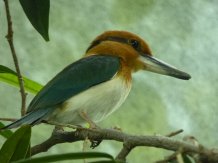Articles

Guam kingfisher - Credit Paul Rose
Birds living in natural habits can help inform captive care
Bird species that live in their natural habitats can help zoos learn how to manage those in captivity, according to a new review.
Birds are the most diverse group housed by zoos around the world, but zoo-based research tends not to focus on birds.
A new article published in the journal Birds, by Dr Paul Rose of the University of Exeter, suggests zoos can improve management of birds by looking at how species live in their natural habitats.
Likewise, birds living under the care of humans can also help guide and develop conservation action for those living in the wild.
“Research into wild birds is extremely useful for furthering how birds are managed in zoos,” said Dr Rose.
“For species of conservation concern, zoo professionals can be linked with field biologists to share information on how to best care for these species in captivity and how to develop and formulate conservation actions.
“We can use proxy species – those common in zoos – to develop practices for conservation that can be used for less familiar species that might be of concern and need help from information gathered through things such as captive breeding.
“Or we can promote the threats that these not-in-the-zoo species face by using the commoner species as an ambassador.
“We do this through my work at the Wildfowl & Wetlands Trust, promoting the rarer species of flamingo that are in the wild using the commoner ones we keep in the living collection.”
In the review, Dr Rose uses hornbills as an example, a species of bird that is essential to the long viability and sustainability of biodiversity in the rainforest.
The helmeted hornbill, a critically endangered species, plays an important role in the dispersal of seeds within pristine, undistributed areas of south-east Asian rainforests.
The population decline of the helmeted hornbill has been caused by poaching of the birds for their “ivory”, the large casque on the bird’s head and bill that can be up to 10% of its overall body mass.
Whilst the helmeted hornbill is not found in captivity, other species of large hornbill are.
By looking at the ecological role of the helmeted hornbill in its natural habitat, zoos have been able to design enclosures that will increase chances of reproduction.
For example, by identifying the temperature and humidity range of hornbill nesting sites in the wild which are more likely to hatch eggs, zoos have been able to use this data to enable them to match these environmental conditions as closely as possible.
A similar situation happened with the Guam kingfishers, a species that is extinct in the wild and reliant on captive breeding for its survival.
Data from the nesting locations of the closely related Pohnpei kingfisher, found on a neighbouring island, showed that temperatures were hotter than those sometimes provided for captive Guam kingfishers.
The findings led to zoos raising the temperature to improve nesting success amongst the species.
Zoos have also been able to guide conservation action for hornbills living in the wild by monitoring the behaviour of these birds and discovering that using nest boxes enhances the quality of habitats for hornbills to breed in, which has led to these boxes being built in areas of the helmeted hornbill’s range in Borneo.
Expertise and financial support has been provided by several large zoological collections in European Association of Zoos and Aquaria (EAZA) and North American Association of Zoos and Aquariums (AZA) that has successfully seen wild rhinoceros hornbills, listed as vulnerable, fledge a chick from an artificial nest box in the Bornean rainforest.
“The effect of visitors on zoos can also help direct future research questions and increase understanding of birds under human care,” adds Dr Rose.
“Developing zoo bird exhibits to theme them around specific conservation messages can be used to promote wider understanding of the threats faced by wild birds specifically and hopefully encourage human behaviour change that benefits ecosystem health.”
The review article published in the Journal Birds, is entitled: “Evidence for aviculture: Identifying research needs to advance the role of ex situ bird populations in conservation initiatives and collection planning.”
Date: 5 February 2021
